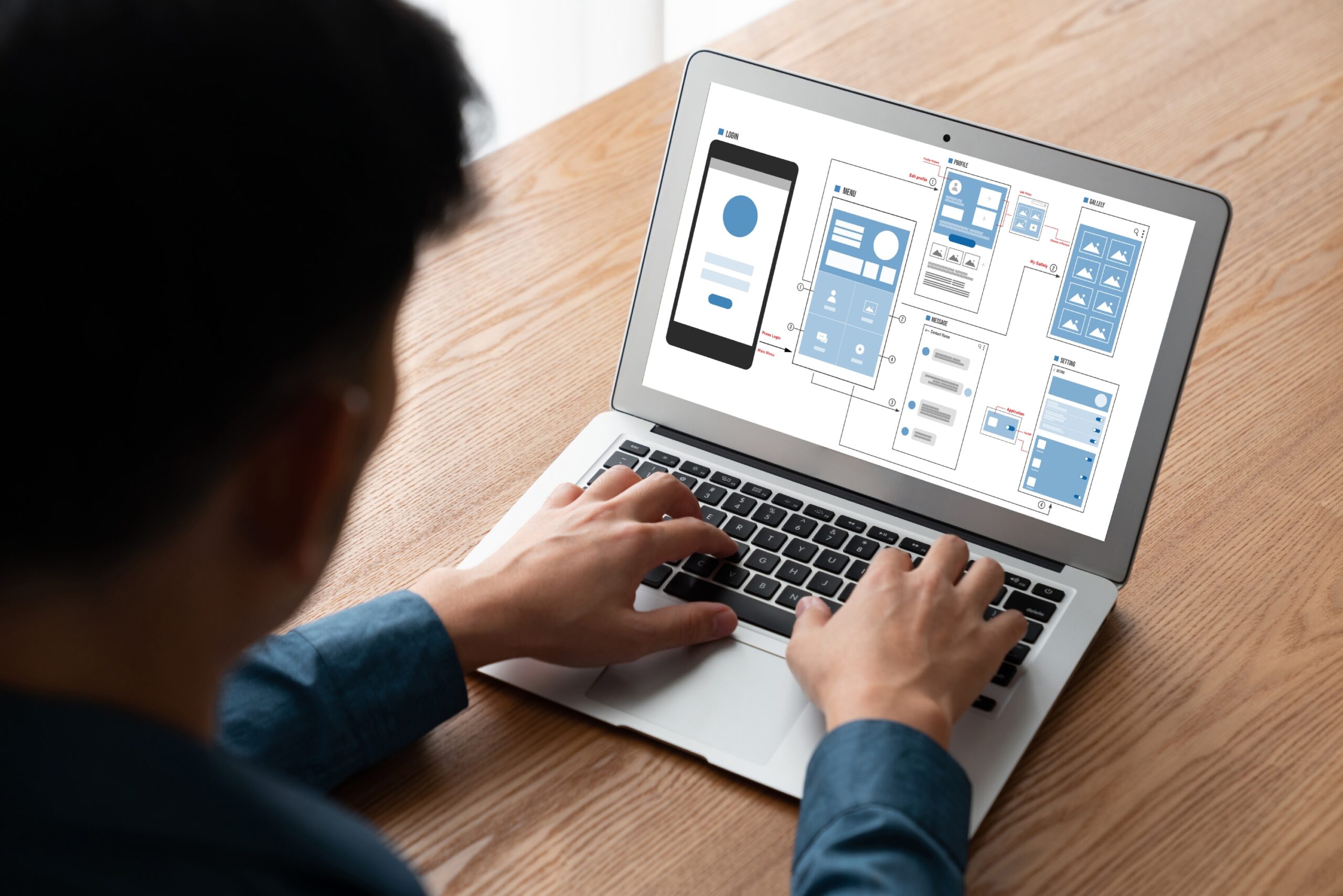When you design a multipage website, platform, or landing page, your goal is to attract visitors who will engage with your content, navigate through different pages, and potentially take actions such as making a purchase. However, for users to truly interact with your site, it needs to be user-friendly and accessible. In this article, we will discuss the importance of checking the usability of a website and explore the key aspects you should consider when evaluating the usability of your web resource. By understanding and optimizing these factors, you can create a website that not only attracts visitors but also provides them with a seamless and enjoyable user experience.
Visual inspection
Ensuring visual accessibility of a website is a crucial aspect that promotes equal opportunities for all users to access and utilize web resources. Ignoring the visual aspect, you lose a large segment of your audience: users with visual impairments or cognitive disabilities, colorblind people, older people, and just exhausted office workers who have no enthusiasm to struggle with inconvenient websites or services. Thus, you should respect and accommodate their needs.
Validating user-defined settings compatibility
Users with visual impairments or motor skill challenges often adjust the display, size, and contrast of text in interfaces to improve visibility and control. Here are some steps to follow:
- On desktops, you can increase the zoom level to 200% by pressing Ctrl + or ⌘ +. This will likely cause the blocks to rearrange and resize, but the overall layout should remain organized without any horizontal scrolling.
- On mobile devices, maximize the font size to ensure that all text within the app adopts the larger size. Additionally, consider adjusting the contrast, boldness, and font style to accommodate the user’s preferences. It is important to verify that the app supports these new settings and adjusts accordingly.
- Enable the auto-rotate feature and verify if the app functions properly in landscape orientation. This is particularly crucial for users who prefer or are required to hold their phones horizontally.
Evaluating touch area and contrast
By ensuring high contrast, we help users with visual impairments or those who use devices in bright sunlight, preventing screen glare and fading. Additionally, by increasing the size of tap areas, we assist those who struggle with accurate screen interactions, such as users with tremors or larger fingers.
You can use various verification tools to assess the contrast ratio on desktops. One of them is the Chrome extension called Colour Contrast Checker. It provides a simple and visually appealing way to evaluate the contrast ratio.
Examining the fonts design
Unstructured dense blocks of text can pose challenges for users, particularly those with visual or cognitive disabilities, when it comes to comprehension. Text that is divided into paragraphs, featuring generous vertical spacing and left alignment, offers a comfortable and effortless reading experience.
Consider the following guidelines for enhancing text readability:
- use a font size larger than 14 pt for web pages and at least 16 pt for mobile apps;
- maintain a line spacing of at least 1.5 times the font size, with paragraph spacing set to twice the line spacing;
- limit the length of articles to 2–3 pages to prevent overwhelming readers.
Assessing the color scheme
Keep in mind that users with color vision impairments may struggle to differentiate even contrasting colors, while those with visual impairments may not perceive variations in hues. It is beneficial to highlight errors or important messages using color to ensure users can quickly notice them. However, it is crucial not to rely solely on color as the only way of conveying information. Always supplement color highlighting with descriptive text.
The visual illustrations check-up
Thoroughly examine your icons, illustrations, and graphics to ensure they are meaningful, clear, and straightforward. It is advisable to position them against a simple and non-distracting background. If there is any uncertainty regarding the correct interpretation of icons, consider providing accompanying labels. This will prevent potential misunderstandings or misinterpretations, particularly for users with cognitive disorders.
Comprehensive logic check
Site logic validation is an integral part of the website development and maintenance process, helping to ensure a functional, reliable, and user-satisfying web resource. It can improve the quality and efficiency of your website, and contribute to the success of your online presence.
Evaluating the structure of pages and blocks
Creating an organized and structured page layout is essential for facilitating user comprehension and engagement. By establishing a clear hierarchy and semantic grouping, you can simplify the perception of content. It is crucial to ensure that important elements stand out from secondary content to prevent users from struggling to navigate the interface.
Users tend to scan pages rather than reading them carefully. Therefore, the design should enable users to quickly and effortlessly locate key information. The ultimate goal is to encourage visitors to take the desired actions on your website. To achieve this, adhere to the following simple guidelines:
- arrange blocks in a hierarchy of importance, placing crucial actions at the top or bottom of the screen;
- make key information easily recognizable at a glance — utilize various visual cues such as color, size, shape, and indentation to emphasize important elements;
- group elements based on their meaning to enhance overall coherence and user understanding.
By implementing these guidelines, you can create a well-structured and user-friendly interface that enables users to navigate your website with ease and achieve their desired goals.
Reviewing and assessing the clarity of texts, articles, and captions
When creating content, it is significant to consider the diverse range of users who will interact with your website or app. To engage this diverse audience, it is recommended to write articles in a simple and clear language. Take the time to review and make sure you’ve followed these rules:
- verify that the article headlines accurately reflect their topics or purposes;
- check whether each paragraph focuses on conveying a single thought;
- enhance understanding by explaining complex terms and abbreviations;
- eliminate idioms, figurative expressions, and excessive generalizations to maintain clarity;
- when it comes to error messages, make sure they provide clear instructions on how to resolve the issue: for links and buttons, the text should clearly indicate the action that will occur upon clicking, or specify the destination the user will be directed to.
By considering the needs of your users, and by implementing these guidelines, you can enhance the clarity and accessibility of your texts, ensuring a positive user experience for all.
Evaluating keyboard accessibility on your website
To accommodate users who have difficulty using a mouse, it is crucial to ensure that your service is accessible via keyboard navigation. Test the functionality by navigating through the page using the Tab key. All interactive elements, such as buttons, links, tabs, checkboxes, and input fields, should receive focus. To activate a control, users should be able to press the space bar or Enter key. Verify that all links are functional and that buttons toggle correctly. Additionally, check if input fields can be filled in. It is important to make keyboard focus clearly visible on all components, ensuring it moves in a logical sequence from top to bottom and left to right.
Assessing website navigation
Implementing effective navigation guidelines benefit all users, but it is particularly helpful for users with impaired concentration. Consider the following principles to improve navigation within your service:
- provide clear indications of the user’s location within the service and offer easy methods to navigate back, access the main page, or explore other sections;
- offer feedback on progress and completion during lengthy tasks to keep users informed and engaged;
- if your service is complex and extensive, ensure multiple avenues for users to find the desired content: this can include a search bar, sections, banners, quick links, and a site map;
By implementing these navigation guidelines, you can enhance the accessibility of your service, making it easier for all users.
Evaluating audio and video accessibility
A fundamental principle to consider is to provide alternative means of accessing content for users with visual or hearing impairments. Take the following measures into account:
- audio files should include a text description of the content;
- video files should have subtitles or closed captions, as well as text descriptions or audio descriptions to provide a comprehensive understanding of the visual elements;
- if your website includes a chat room, ensure there is an option for voice control, allowing users to interact without relying only on text input.
By implementing these accessibility measures, you can ensure that individuals with visual or hearing impairments can fully engage with your audio and video content.
Conclusion
Website or service usability testing offers numerous benefits, including improved user experience, higher conversion rates, increased user satisfaction, and a competitive advantage. It is a crucial process that ensures the creation of a user-friendly and enjoyable website for all users, regardless of their level of experience or the device they use to access the site.
Furthermore, website and service accessibility is not only a moral and ethical responsibility but also a critical factor for business success. It contributes to building a positive reputation and can increase the overall business performance. Ultimately, prioritizing accessibility is a beneficial solution for all stakeholders — users, businesses, and society as a whole.
If you want to reach new GEOs and audiences, maybe it is all waiting for you on Telegram? We’ve prepared some material about Telegram audiences. What are the messenger’s users like this year? How old they are, what they do, and what they are interested in!








